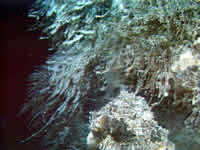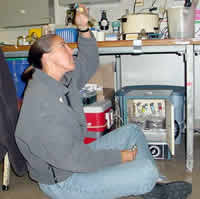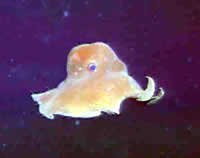| |
| |

Hell vent is one of the high-temperature
hot springs (~300° C, 572° F ) in
the ASHES vent field. Hot water exits from a chimney of sulfide minerals
that is 5 meters high and is covered with tubewormsy. |
|
Hyperthermophiles
- They Like it Hot!
I began my morning in ROPOS's control room waking up to a view of the
many
faces of ASHES vent field. Within ASHES there are many individual
high-temperature hot springs. Some sites were filled with formations that
resemble white, 10-scoop snowcones that are actually vent chimneys made
out
of the mineral anhydrite (thank goodness it was real - at this hour, the
whole snowcone visual could have been a bizarre dream). Other sites show
off
smaller clumps of anhydrite chimneys that remind me of funky marshmallows
(Chef Sean made us a great meal last night and I was still full at
bedtime-can you tell?). Still other sites have amorphous, blobby-shaped
chimneys made out of sulfide minerals that are not as hot and covered
with
beautiful worms of all types, while other areas remind me of rolling
pastures. These were filled with mounds of tubeworm bushes and were so
pretty. What a way to wake up!
| |

Lab Technician Sheryl Bolton holds up her
test tubes to see if any of her
archaea cultures grew. |
|
During
my video logging duty, I had an opportunity to find out more about the
work of Sheryl Bolton, a lab technician working with oceanographer Dr.
John Baross at the University of Washington. Sheryl studies tiny forms
of life in a group known as archaea. Back when I was in high school biology,
we had to memorize five kingdoms of life (animals, plants, fungi, protists,
and monera). That classification system was based upon the ability of
early scientists to look at an organism's characteristics and make a judgement
call into which category it should be placed. Nowadays, technology allows
us to be more quantitative with our classification. For example, scientists
working at the molecular level, like Sheryl, can compare the DNA from
new organisms that they find in their samples to DNA from known organisms
to place them in a classification scheme that is much more objective.
With the help of this technology, scientists divided the two prokaryotes
into two Domains: bacteria and archaea, their own Domains. While you may
be familiar with bacteria as that friendly little critter that naturally
occurs in your intestines (one of the many reasons you wash your hands
before you eat), you may not be as familiar with archaea, some of which
are the "extremophiles". As their name suggests, these guys
like extremes! They live in environments where no other critters would
dare to go, some of which are those with high salt content (like salt
lakes), low temperatures (like the Arctic), and high temperatures (like,
you guessed it, hydrothermal vents).
| |

This unusual octopus crossed ROPOS's path
today at ASHES vent field! . |
|
On
this particular morning, Sheryl was excited because a sample that ROPOS
had collected on the 16th of July at Cloud vent contained archaea, which
she has managed to keep alive and reproducing in her lab on the ship.
She told me that even though the sample was taken from water that was
only 5.6° C (42° F). This particular species was happy living
in temperatures all the way up at 70° C (158° F), suggesting that
there are much warmer conditions below the seafloor. From experiments
she's conducted on the ship so far, she's been able to verify that this
location is teeming with archaea. When she gets back to her lab on shore,
she'll actually run DNA analyses on them to try to determine what specific
kind of Archaea they are and to see if she has found a new genus or species.
No wonder she's excited! I wonder what ROPOS will bring us next!
|
|
| |
Student's
Question of the Day:
C.
M. New Paltz, New York asks, "Do you need to wear special clothing
when
you go out to sea?"
The temperature
is comfortable where we are working right now. Most of us
have been wearing slacks, t-shirts and a lightweight jacket during the
day.
We prefer to wear old clothes while we are working on the ship. You wouldn't
want to wear your dress-up clothes out to sea to work on samples - you
might
stain them or spill chemicals on them. Another piece of special gear we
need
while we're on the ship is a hard hat for when we're working on the deck.
Even though we don't walk around on the fantail (back deck) when the cranes
are in operation, there is a lot of equipment placed high over our heads,
and we are careful to prevent injury should something shift during the
cruise. Also, we are very careful to always remember to wear our work
vests
when we are on deck. Like the life jacket that you might wear while you
are
out canoeing, they are lightweight to allow for efficient movement.
|
|

